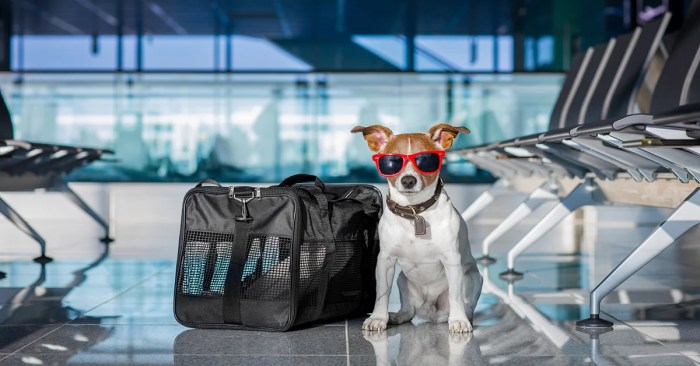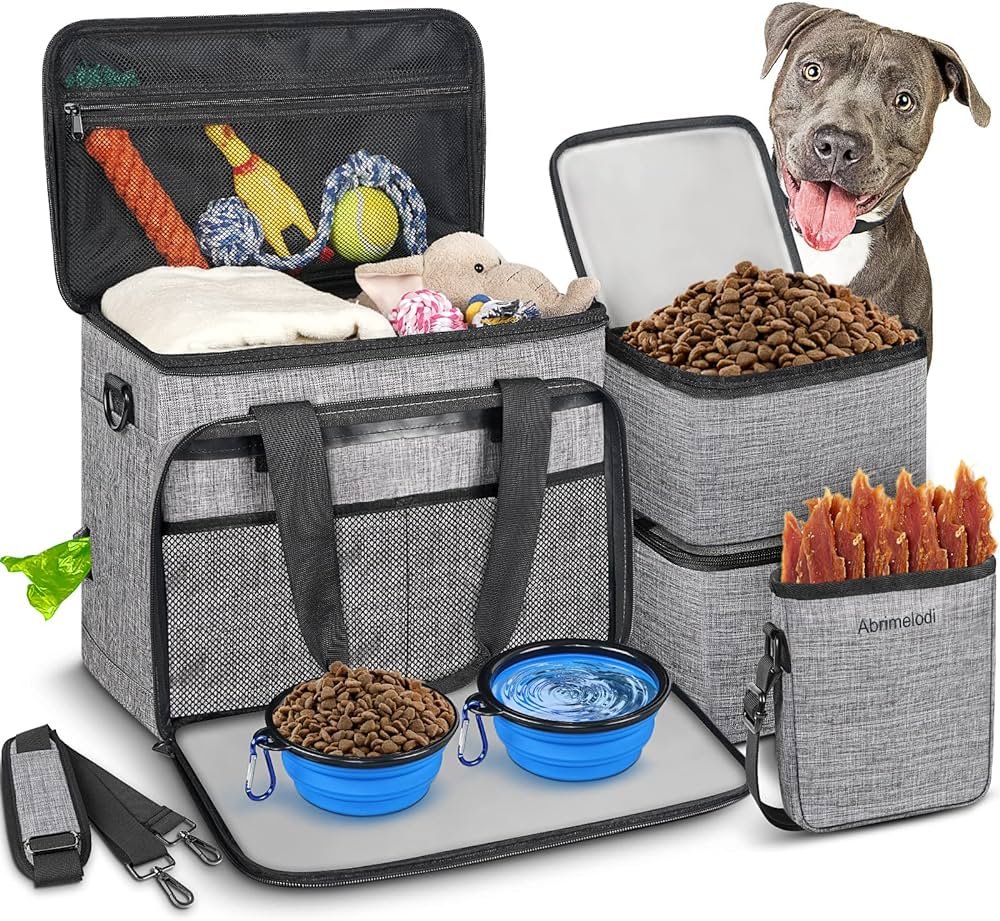
How to prepare your pet for travel is a crucial topic for any pet owner planning a journey. Successfully navigating this process ensures a safe, comfortable, and stress-free experience for both you and your furry friend. From meticulous pre-travel preparations, including health checks and packing essentials, to understanding transportation regulations and selecting pet-friendly accommodations, careful planning is paramount.
This guide will walk you through every step, providing practical advice and valuable insights to make your pet’s travel adventure a positive one.
We’ll cover everything from choosing the right carrier and creating a travel itinerary that caters to your pet’s needs to managing potential anxieties and handling travel-related emergencies. We’ll also explore various transportation methods, comparing their suitability for pets and highlighting safety precautions. Finally, we’ll offer tips for post-travel care, helping your pet readjust to home life after their journey.
Pre-Travel Preparations for Pets

Preparing your pet for travel involves careful planning and attention to detail to ensure a safe and comfortable journey for both you and your furry friend. Thorough preparation minimizes stress and potential problems, allowing you to enjoy your trip to the fullest. This section will guide you through essential pre-travel steps.
Essential Travel Items for Pets
A well-stocked travel kit is crucial for a smooth trip. The following checklist categorizes essential items to help you stay organized. Remember to adapt this list based on your pet’s specific needs and the length of your journey.
| Health | Comfort | Food & Water | Other Essentials |
|---|---|---|---|
| First-aid kit (pet-specific) | Favorite blanket or toy | Enough food for the trip plus extra | Pet carrier (appropriately sized) |
| Medication (if applicable) | Travel bed or mat | Food and water bowls | Leash and collar/harness |
| Copy of vaccination records | Travel-sized grooming supplies | Water bottle for travel | Poop bags |
| Veterinarian’s contact information | Collar with ID tags | Treats | Copies of pet’s registration papers |
Acclimating Your Pet to Their Carrier
Introducing your pet to their travel carrier well in advance of your trip is vital to reduce anxiety during travel. Start by leaving the carrier open in a familiar area of your home for several days. Place treats and toys inside to create positive associations. Gradually increase the time your pet spends inside the carrier, rewarding calm behavior with praise and treats.
Short car rides around the neighborhood can also help your pet get used to being in the carrier while traveling. Avoid forcing your pet into the carrier; instead, encourage them with positive reinforcement.
Importance of Microchipping and Updated Vaccinations
Microchipping your pet provides a permanent form of identification, significantly increasing the chances of their safe return should they become lost during travel. Ensure your pet’s microchip information is up-to-date with your current contact details. Furthermore, updated vaccination records are essential, not only for your pet’s health but also often required by airlines, transportation services, and accommodations. These records demonstrate your pet is protected against common diseases, protecting both your pet and others.
Consult your veterinarian well in advance of your travel date to ensure all necessary vaccinations are administered and documented.
Sample Pet Travel Itinerary
A well-planned itinerary considers your pet’s needs. This sample itinerary demonstrates how to incorporate regular breaks and feeding times. Remember to adjust this based on your specific travel distance and your pet’s individual requirements.For a 6-hour drive:* 0:00 – 1:00: Depart. Ensure your pet is securely in their carrier.
1
00 – 1:30: First rest stop. Allow your pet to relieve themselves and stretch their legs (in a secure area). Provide fresh water.
2
30 – 3:00: Second rest stop. Similar to the first, with a focus on hydration and elimination.
4
00 – 4:30: Feed your pet a small meal or treats, depending on their usual feeding schedule.
5
00 – 5:30: Final rest stop before arrival. Water and potty break.
6
00: Arrive at destination.
Transportation Methods & Pet Safety
Safe and comfortable travel for your pet requires careful planning and consideration of the chosen transportation method. The best option depends on the distance, your pet’s size and temperament, and any specific health concerns. Each mode of transport presents unique challenges and safety considerations that must be addressed to ensure a stress-free journey for both you and your furry friend.Choosing the right method of transportation is crucial for your pet’s safety and well-being.
Consider factors such as distance, your pet’s size and breed, and any health conditions.
Transportation Method Comparison
The following table compares car, plane, and train travel for pets, highlighting key differences in pet-specific requirements and safety considerations.
| Transportation Method | Pet-Specific Requirements | Safety Measures |
|---|---|---|
| Car | Secure carrier or restraint system; adequate ventilation; regular breaks for water and potty; appropriate climate control. | Secure your pet in a carrier or with a harness and seatbelt. Ensure adequate ventilation and temperature control. Plan regular stops for rest, water, and elimination. |
| Plane | Airline-specific requirements for carriers, documentation (health certificates, etc.), and in-cabin vs. cargo transport; potentially sedatives (consult your vet). | Choose an airline with a good reputation for pet transport. Ensure the carrier is appropriately sized and secure. Follow all airline regulations meticulously. Consider booking a direct flight to minimize stress. |
| Train | Carrier required; often restricted to smaller pets; check with the train company for specific regulations and restrictions on pet size and type. | Ensure your pet’s carrier is secure and well-ventilated. Keep your pet calm and quiet during the journey. Supervise your pet closely and be mindful of other passengers. |
Flying with Pets: Regulations and Requirements
Air travel with pets requires careful adherence to airline-specific policies and regulations. These vary significantly between airlines and even between destinations. It’s crucial to contact your chosen airline well in advance of your flight to confirm their pet transport policies, including permitted carriers, documentation needed, and any restrictions based on breed or size. Many airlines require health certificates from your veterinarian, issued within a specific timeframe before the flight.
Furthermore, understanding whether your pet will travel in the cabin or as cargo is vital, as cargo holds can be stressful and potentially dangerous for some animals. Booking direct flights is highly recommended to minimize the risk of your pet getting lost or delayed during transfers.
Safe Road Trips with Pets
Road trips with pets can be enjoyable for both you and your pet, but require planning to ensure safety and comfort. A secure carrier or restraint system is essential to prevent your pet from injuring itself or distracting you while driving. Regular stops are crucial for your pet to relieve itself, drink water, and stretch its legs. Maintaining a comfortable temperature inside the vehicle is also vital; avoid leaving your pet unattended in a hot car.
Preventing car sickness is important for a pleasant journey. Avoid feeding your pet a large meal before the trip. Try giving your pet a small amount of food several hours before departure. For pets prone to car sickness, consult your veterinarian about potential medication to alleviate symptoms. Keeping your pet comfortable and relaxed is key; consider playing calming music or bringing familiar toys.
Providing fresh water throughout the journey is also essential.
Accommodation & Pet-Friendly Options
Securing suitable pet-friendly accommodation is crucial for a stress-free trip. Finding the right place involves more than just a quick online search; it requires careful consideration of your pet’s needs and the specific policies of different lodging options. This section will guide you through the process of identifying, contacting, and preparing pet-friendly accommodations for a smooth and enjoyable journey for both you and your furry friend.
Finding Pet-Friendly Accommodations
Numerous resources exist to help locate pet-friendly hotels, vacation rentals, and other accommodations. Websites such as Booking.com, Expedia, and Airbnb often allow you to filter your search results to show only pet-friendly options. Many dedicated pet travel websites and apps also exist, providing detailed information on pet policies, amenities, and reviews from other pet owners. For example, BringFido.com specializes in connecting pet owners with pet-friendly accommodations and activities.
These resources provide a wide range of choices, from budget-friendly motels to luxurious resorts, catering to diverse travel styles and budgets.
Important Questions to Ask Potential Accommodations
Before booking, it is essential to clarify the accommodation’s pet policies and associated fees. A list of questions to consider asking includes: What are the pet fees (if any)? What are the size and breed restrictions (if any)? Are there any designated areas for pets (e.g., outdoor spaces)? Are there any additional cleaning fees or damage deposits?
What are the rules regarding leaving pets unattended in the room? What emergency veterinary services are available nearby? Confirming these details in advance prevents unexpected charges or complications during your stay.
Ensuring Your Pet’s Comfort and Safety in Unfamiliar Environments
Creating a comfortable and secure environment for your pet in unfamiliar surroundings is vital to minimize stress and anxiety. This involves bringing familiar items such as their bed, toys, and food bowls to help them feel more at home. Establish a designated space for your pet within the accommodation, perhaps a corner of the room or a designated area with their bed and toys.
Ensure the space is safe and secure, free from hazards such as electrical cords or toxic substances. Familiar routines, such as regular feeding and walking times, should be maintained as much as possible. If your pet is prone to anxiety, consider using pheromone diffusers or calming treats to help them relax.
Creating a Comfortable and Safe Space for Your Pet
The chosen space for your pet should be easily accessible and clearly defined. It should be well-ventilated and away from high-traffic areas. If your pet is crate-trained, bringing their crate can provide a safe and secure haven. Ensure the crate is appropriately sized and comfortable, and include familiar bedding and toys. For pets who are not crate-trained, a designated area with soft bedding, toys, and water bowls will create a comfortable space.
Secure any potential hazards, such as loose wires or cleaning products, and ensure the area is well-lit. A nightlight can also be beneficial for pets who are anxious in the dark.
Pet’s Health & Well-being During Travel: How To Prepare Your Pet For Travel

Traveling with your pet requires careful consideration of their health and well-being. The stress of unfamiliar environments, changes in routine, and potential exposure to illness can significantly impact your pet’s comfort and health. Proactive planning and preparation are key to ensuring a safe and enjoyable trip for both you and your furry friend.
Potential Health Concerns and Preventative Measures
Prioritizing your pet’s health before, during, and after travel is crucial. Several factors can contribute to health issues during travel, including stress, changes in diet and hydration, and exposure to new pathogens. Taking preventative measures significantly reduces the risk of these problems.
- Motion Sickness: Some pets experience nausea and vomiting during travel. Consult your veterinarian about anti-nausea medication suitable for your pet’s breed and age. Avoid feeding your pet a large meal before travel.
- Dehydration: Travel can lead to dehydration, especially in hot weather. Always provide fresh water, and consider adding electrolytes to the water, particularly during longer journeys.
- Stress and Anxiety: Travel can be highly stressful for pets. Using calming aids like pheromone diffusers or calming treats can help alleviate anxiety. Maintaining a consistent routine as much as possible will also help.
- Exposure to Infectious Diseases: Contact with other animals at rest stops or in accommodation can expose your pet to infectious diseases. Ensure your pet’s vaccinations are up-to-date before travel and avoid contact with unfamiliar animals.
- Injuries: Unexpected accidents can happen. Ensure your pet is properly secured during transport to prevent injuries from sudden stops or collisions.
Managing Pet Anxiety During Travel
Travel anxiety in pets manifests in various ways, from excessive panting and drooling to trembling and vocalization. A calm and reassuring approach is vital.
- Familiar Items: Bring familiar items like your pet’s bed, toys, and blankets to create a sense of security and comfort.
- Calming Aids: Consult your veterinarian about calming medications or supplements that can be safely administered during travel. Pheromone diffusers can also help create a calming atmosphere.
- Gradual Acclimation: If your pet is prone to anxiety, gradually acclimate them to the travel environment before the actual journey. Start with short car rides or trips to new locations.
- Positive Reinforcement: Reward calm behavior during travel with treats and praise. This positive reinforcement helps associate travel with positive experiences.
Handling Travel-Related Emergencies
Despite careful planning, unexpected situations can arise. Being prepared for potential emergencies is essential.
- Lost Pet: Ensure your pet is wearing a collar with identification tags and consider microchipping. Take a recent photo of your pet before you leave. If your pet goes missing, immediately report it to local authorities and animal shelters.
- Injury: A well-stocked first-aid kit is crucial for minor injuries. For serious injuries, seek immediate veterinary attention. Know the location of the nearest veterinary clinic along your route.
- Illness: Monitor your pet closely for signs of illness during and after travel. If you notice any unusual symptoms, contact your veterinarian immediately.
Importance of a Well-Stocked Pet First-Aid Kit, How to prepare your pet for travel
A comprehensive pet first-aid kit is a necessity for any pet travel. It should contain items to address minor injuries and illnesses.
- Essential Supplies: Include antiseptic wipes, gauze pads, bandage rolls, scissors, tweezers, thermometer, and any medication your pet regularly takes.
- Emergency Contact Information: Keep a list of emergency veterinary clinics and your veterinarian’s contact information readily accessible.
- Pet’s Medical Records: Carry a copy of your pet’s vaccination records and any relevant medical history.
Preparing your pet for travel involves careful consideration of various factors, from pre-trip health checks and packing necessities to choosing suitable transportation and accommodations. By following the guidelines Artikeld in this guide, you can significantly reduce stress for both you and your pet, ensuring a smooth and enjoyable travel experience. Remember, proactive planning and attention to detail will pave the way for a memorable adventure shared with your beloved companion.
Safe travels!
FAQ Resource
What documents do I need for my pet to travel internationally?
International pet travel requires specific documentation, including a valid microchip, up-to-date vaccination records (rabies is typically mandatory), and possibly a health certificate from your veterinarian issued within a specific timeframe before travel. Requirements vary by country, so check with your destination’s embassy or consulate.
How can I prevent my pet from getting carsick during a road trip?
To minimize car sickness, feed your pet a light meal several hours before travel. Keep the car cool and well-ventilated. Short, frequent stops for walks and water breaks can also help. Consult your vet about medication if necessary.
What should I do if my pet gets lost during travel?
Ensure your pet wears a collar with identification tags including your contact information. Consider a GPS tracker. Immediately report your pet missing to local authorities and animal shelters. Post flyers with your pet’s picture and description.






